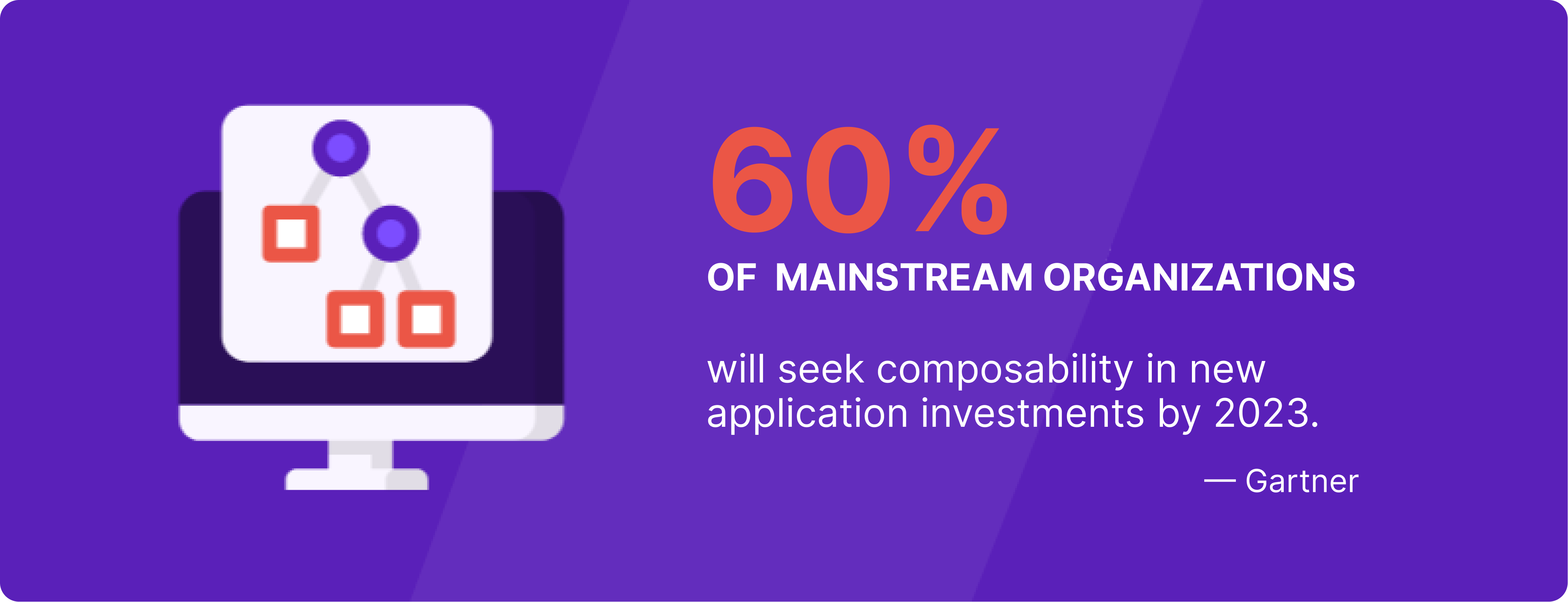Composable architecture: Core principles for building scalable systems

Share

Discover the advantages of composable architecture in building flexible, scalable systems. Embrace modular design, microservices and cloud-native solutions for better adaptability and efficiency. Talk to us today to learn more.
Highlights
You’ll learn about the core principles of composable architecture.
- Modularity: Break systems into independent units for flexibility and scalability
- Reusability: Use components across multiple applications to save time and resources
- Flexibility: Update or replace modules at will and plug into the latest tech trends
Explore how composable architecture can enhance your digital strategy.
Businesses face increasing pressure to adapt and innovate to stay competitive. Traditional systems often fail to meet this demand. This leads to inefficiency and missed opportunities. A composable architecture addresses that gap, allowing you to build software from modular, reusable components.
Composable architecture supports faster innovation, and new technology can be added without overhauling the system. We explore the core principles of composable architecture, its benefits, and how it compares with monolithic systems.
What is composable architecture?
Composable architecture is a design approach that allows you to build adaptive applications. It treats the front-end and back-end code as separate entities, which makes development easier. Typically, it is built into a DXP that comes with a headless CMS. A composable architecture is built on three main concepts:
- Modularity: This principle decomposes a system into small independent parts. Every module has its specific function, making it easier to manage tasks, collaborate on projects, and scale up.
- Reusability: Components are built once and used in multiple applications. This approach saves time and resources.
- Flexibility: A composable architecture enables you to substitute or update components without interfering with the whole system, leading to faster updates and product releases.
Start your free trial with Contentstack today. Transform your brand's digital presence with Contentstack's open MACH architecture and industry-leading technology. Witness a significant reduction in publishing and development time, and elevate your content management. Start your free trial now.
Composable vs. monolithic architecture
Choosing the right architecture can impact the performance of your tech stack. You can go composable if you face issues with scaling your current system. Here is a comparison of both approaches:
Aspect | Composable | Monolithic systems |
Structure | Uses modular parts that function without dependence on each other. | A single, integrated unit with all parts connected. |
Scalability | Scale individual units based on demand. | Requires scaling the entire application, which is complex. |
Flexibility | Update or replace modules without affecting the whole. | Changes often require changes across the system. |
Development speed | Allows faster updates and feature additions. | Slower because the modules depend on each other. |
Fault tolerance | Issues in one part of the system do not affect others | Problems in one part can impact the whole system |
Core principles of composable architecture
These core principles are the building blocks that help create resilient, flexible, and modular applications.
Modular design
A composable architecture offers flexibility by breaking systems into smaller, independent units. It allows you to manage DXP components more effectively. This method allows teams to focus on specific modules to get work done simultaneously. A modular design also makes it easier to repurpose existing system units instead of rebuilding features from scratch, saving both time and resources.
Microservices
Microservices enable an application to be structured into smaller services. Each service handles a specific business function and is managed by a separate team. They are loosely coupled, and each service can be deployed independently. For instance, if you need extra resources for user management, you can scale this service without touching other modules related to order processing.
API-first
Building composable architecture requires APIs to connect the different modules and microservices. An API-first approach emphasizes integration and seamless interaction. It extends your system's capabilities without complications.
Cloud-native
Cloud-native solutions are designed to leverage the scalability of cloud infrastructure. They enhance resilience and flexibility within the cloud environment. They also support agile practices like DevOps and serverless. With cloud-native solutions, organizations can build resilient and scalable applications.
Headless CMS
A headless CMS is more flexible than traditional content management systems (CMS). It is not tied to a specific front-end framework. Hence, you can deliver content to multiple platforms via APIs. This setup allows for tailored content delivery. You can engage with your customers on their preferred digital channel.

Case studies
MongoDB
MongoDB struggled with managing five core websites and multiple content management systems. They could not align their IT systems and the business side. They quickly transformed their digital strategy by opting for Contentstack’s composable DXP. That led to faster publishing, robust support for seven languages, and over 250 pages migrated quickly.
Hear from Subi Babu, the Engineering Lead at MongoDB. "Coming from an in-house CMS, our background for several years was focused on developing CMS features. Now, we can use the marketplace and get plug-and-play integrations, which is exciting."
Read more about how MongoDB powered digital modernization via a composable DXP.
Waltz Health
Waltz needed a platform to merge product data, pricing and branded asset templates. Contentstack’s composable DXP offered that. It also allowed Waltz to integrate third-party services to improve patient care.
Hear from Sunil Kripalani, the CTO. "The flexibility that's baked into Contentstack isn't just enabling our staff to work more efficiently, it's a true business enabler that's helping us consider new service offerings. Using APIs, we can pull in new data streams and create unique experiences for our provider partners, as well as within niche markets."
Read about Waltz Health's DXP integration success.
Benefits of composable architecture
Systems that need regular updating or scaling can be complex and hard to manage. Going composable allows you to manage such issues and provides benefits as follows;
- Scalability: You can scale single modules as per demand. For instance, you can scale your payments module during peak sales. You don’t need to upscale other parts of the system.
- Flexibility: A composable architecture allows you to adapt to changing business needs. For example, if you need to add a new CRM system, you can do so as an extension rather than rebuilding the entire platform.
- Reusable components: Composable architecture supports component reuse. For instance, you can use a customer feedback module on your website and integrate it with your mobile app and internal tools. This will save time and promote consistency.
- Improved load balancing: It allows for effective load distribution across modules. This balance prevents any single part from becoming a bottleneck, improving overall system performance and reliability.
Steps to implement a composable architecture
Here are the steps to transition from monolithic to composable architecture
- Evaluate the current systems: Assess your infrastructure to identify parts that could be replaced or upgraded.
- Define modular components: Identify specific functions and services that will become independent modules. For instance, you can have separate modules to manage user data and inventory or to process orders.
- Choose the right technology: If your goal is to manage and publish content projects, opt for a headless CMS. However, if you focus on optimizing entire customer journeys, a composable DXP is the better choice.
- Implement APIs: Design and run reliable APIs to allow modules to share data. This ensures that different parts of your system can collaborate and share information.
- Testing and improvement: Test the system to ensure it works. Make changes if needed.
Contentstack: Your partner in scaling digital experiences. Twice named a Leader in Forrester's composable DXP award, Contentstack offers an innovative approach to DXP. Experience our 100% microservices architecture and API coverage that allows instant scalability. Start your free trial today.
Composable architecture in e-commerce
Composable architecture offers a component-based solution that enables businesses to build unique customer experiences. You can plug best-of-breed building blocks like checkout, carts, and payments. It uses packaged business capabilities (PBCs), which are connected via APIs.
Traditional e-commerce platforms often struggle with scaling and integration, making it difficult for retailers to meet modern e-commerce demands. A composable model fixes this issue by allowing you to build your platform from independent, interchangeable parts.
Benefits of composable architecture for e-commerce platforms
Composable system offers significant advantages for your e-commerce business:
- Personalization: You can integrate AI-driven recommendation engines. This allows you to tailor shopping experiences across different customer segments.
- Omnichannel experiences: Maintain content, transactions, and customer interactions across multiple platforms and devices to ensure a consistent brand experience for your customers.
- Rapid feature deployment: Launch new features or promotions without rebuilding your entire system. That way, you can quickly respond to market trends or seasonal demands.
- Improved performance: Scale individual segments like search or checkout as needed. This speeds up the site during busy times, like sales events.
- Easy third-party integrations: Combine best-of-breed solutions for payments, shipping, or analytics to keep your platform flexible and future-proof.
FAQ section
What is composable architecture?
Composable architecture is a design pattern that allows you to build software from separate, reusable parts. These parts connect via APIs to create flexible, scalable systems.
What is a composable architecture standard?
It is a set of rules and methods to build software parts that work together and can be swapped out. It ensures that different systems can interact and stay consistent.
What is the difference between microservices and composable architecture?
The main difference is in the separation of concerns. Microservices are small, independent units serving specific business functions, while a composable architecture consists of components that can be interchanged or reused.
What is the difference between modular and composable architecture?
Modular architecture focuses on separating components. Each component has a defined interface. Composable, however, emphasizes reusable and interchangeable parts.
Learn more
A composable architecture enables you to create resilient, flexible, and scalable applications. It supports modularity and improves time-to-market. As the basis of a composable DXP, it gives you the tools to manage and optimize entire customer journeys.
Contentstack offers the best-in-class composable DXP built on MACH principles, with enterprise-grade security and support for easy onboarding. Talk to us today to see how it works.



